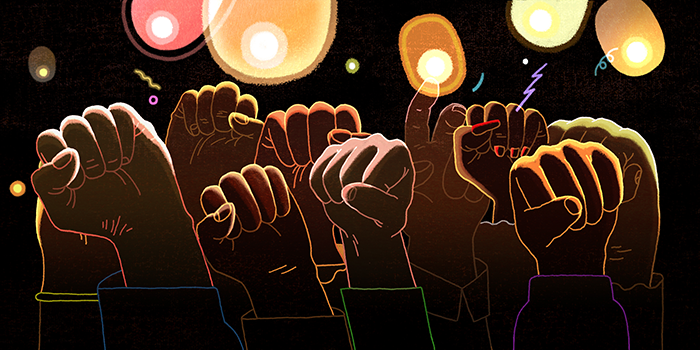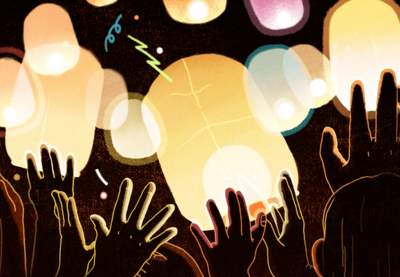The morning of March 17, 2021, I woke up with puffy eyes, a pounding head and a mouth that felt stuffed with wool. I’d stayed up too late the night before, grieving. Eight people had been killed in the Atlanta area, six of whom were Asian women, and the anger and pain had overwhelmed me. Those women looked like my aunties, like my ancestors, like me.
I fumbled for my phone and was surprised to find it full of unread messages. One was from my cousin who lives in New York, expressing her sorrow and her fear, reaching out to make sure I was OK, for some reassurance that she was OK. But the messages were not only from other Asian people. A multiracial group of friends and colleagues had reached out to say, “I know you are hurting. I know what this hurt feels like. I want to hold it with you. Together, we can change this.”
This last belief—Together, we can change this—is foundational to the practice of solidarity, to working in diverse coalitions toward positive change.
Over the past year, we have seen massive movements for racial justice. Much of the focus has been on fighting anti-Asian and anti-Black racism, and these struggles have often been represented as separate fights, parallel lines that will never intersect. And yet, all forms of racism, as well as successful efforts against them, are deeply interconnected. Teaching about solidarity, including Black and Asian solidarity, can help students recognize ways that they can work together for justice.
As educators, we can support students’ understanding of what solidarity is and encourage their sense of ownership and empowerment around acting in solidarity with others. To do this, however, we’ll need to lift up a few key concepts about solidarity that students should know. This includes teaching and celebrating the history of multiracial solidarity, recognizing with students the ways white supremacy makes solidarity challenging, and stressing for young people the ways solidarity pushes beyond connection or empathy into shared action for change.
Solidarity Requires Relationships
In California, Lailan Huen is Oakland Unified School District’s Program Manager for Asian Pacific Islander Student Achievement (APISA). This March, in the wake of recent tensions and violence in the Oakland community—tensions that have long existed and have flared up in the past—Huen worked with high school students to organize a workshop series: Black & Asian, Pacific Islander & SWANA (South West Asian & North African) Student Solidarity.
The three goals of the series were “Knowing Our History,” “Current Issues” and “Building Forward Together.” In the workshop, students shared and listened to each other’s stories with the aim of building stronger solidarity between groups. They started with understanding each other’s identities and their communities’ histories, an intentional choice.
Huen emphasized the foundational importance of storytelling to solidarity efforts. “A big piece of the recommendations from students and our community,” she explains, “is that we have to learn about each other through ethnic studies, through storytelling and sharing across our communities. … That has to happen before we can really meaningfully build solidarity.”
Deepa Iyer, a writer, activist and staff member at the Building Movement Project, describes solidarity this way: “Some people think it’s sort of like a buzzword and it doesn’t mean anything beyond a hashtag or a slogan. And that’s our challenge: How do we move towards using our sense of connection and common cause with each other to create change, to build collective power, to transform our communities?”

Solidarity Isn’t New
As the goals of the Oakland workshop make clear, understanding a shared history—building connections, recognizing what solidarity really is, and understanding the legacies upon which today’s solidarity efforts build—is a necessary first step for students to take meaningful action. For educators, that means teaching not only the histories of individuals and communities but also the history of solidarity movements.
In the last year, we’ve seen increased public awareness of social issues that affect all of us, with young people showing up to support efforts ranging from climate justice to immigration rights to Black Lives Matter and more. Media coverage has focused on how racially diverse these protest movements appear, especially when compared to similar protest movements of the past.
In news photographs of the Stop Asian Hate marches, for example, the faces I saw in the streets looked like the group of people who had reached out to me privately. And yet, even though multiracial solidarity might be more visible than ever before, it is not new.
One example of historical solidarity to highlight with students is that of the San Francisco State College (now San Francisco State University) student strike of 1968 and 1969. Led by a multiracial coalition of students of color known as the Third World Liberation Front, the strike built on the groundwork laid by the Black Student Union (BSU) at San Francisco State, the very first BSU in the United States.
This story is particularly valuable because it can help students understand some key points about solidarity itself: that solidarity is built on activism, that solidarity is a necessary response to policies that seek to divide marginalized groups, and that young people have the power and agency to create change through solidarity.
At San Francisco State, the BSU students had previously organized around Black studies and guaranteed admission slots for Black students. When Asian and Latinx students learned about the admissions guarantees, they wanted the same. But the college responded by saying the Black students would have to share their allotment.
In a moment that led to political awakening for many young people, the Third World Liberation Front showed that collective organizing was key to a fundamental shift toward justice, an effective alternative to a zero-sum model that encourages communities of color to fight for a scarcity of resources divvied up amongst themselves.
Seeing the ways that white supremacy works to prevent or interrupt solidarity is a necessary foundation for recognizing such tactics.
Solidarity Isn’t Always Easy—and There’s a Reason Why
“I think it’s important to talk about the complexities that are created by white supremacy that put communities in a situation where they feel like they have to fight for the scraps,” Iyer says. “That enables us to understand the root causes of why the divisions are happening.”
In response to the Atlanta spa killings, I saw some Asian Americans react using anti-Black language and invoking the model minority myth, a stereotype that places Asian people above Black people in a racial hierarchy. I saw some Black Americans react with anti-Asian comments, saying they shouldn’t put energy into pushing back against anti-Asian racism because it’s a distraction from Black liberation.
These responses show how, even today, we often find ourselves divided against each other rather than fighting alongside one another against a system that keeps us all in positions of oppression. Importantly, people on both sides invoked the 1992 Los Angeles Uprisings as justification for this mistrust and division between communities.
Students will have seen harmful language and references to historical divisions, too. When teaching about historical and present-day coalitions, it’s important to share real histories and challenge both the systems and the popular narratives that work to prevent solidarity.
When learning about the L.A. Uprisings, for example, students deserve the truth. They should know that Latasha Harlins, a 15-year-old Black girl, was shot and killed by a Korean store owner, who was sentenced to only probation and a $500 fine. They should know that this verdict—which treated Harlins’ life like it didn’t matter—came in the same month a jury found four white police officers not guilty in the videotaped assault of Rodney King. They should know that during the uprising, South L.A. burned for days. They should know that Korean-owned businesses were disproportionately targeted.
But while educators cannot gloss over the complex, historically fraught relationship between Black and Korean communities in South L.A., students should also recognize that there is an incentive for some groups to maintain narratives of division. They should know that parts of L.A. were on fire, and many people who supported the decades of discriminatory policies that led to the violence watched neighborhoods burn from the comfort of their living rooms. In short, they should know that there’s a reason why solidarity isn’t always the easiest, most intuitive answer to problems.
The website Solidarity Stories is a project of the Solidarity Working Group of the National Asian American Leaders Table on COVID-19 Racism. The site features stories of solidarity in action through videos and interviews with Asian American and Pacific Islander community leaders. Their resource “Crises Bring Possibilities to Build Together” includes an important counternarrative about what happened in L.A. in 1992, one that recognizes the harm while also recognizing the role of white supremacy in encouraging that harm.
“The Uprising,” they write, “was the outcome of structural racism that kept communities of color in poverty, in tension, and conflict.” In other words, Black and Korean communities had been set up to be in conflict. And yet, the Uprising was also a moment of awakening for many Korean Americans who realized an alternative situation, one in which they could “unite in true solidarity with Black and other communities of color who share the same values and vision of an equitable world for all.”
Ultimately, Solidarity Is About Action
While it’s critical that students understand the history and the challenges of solidarity, they must also know that connecting with others and identifying common oppression is a first step to justice, not an end goal.
Seeing the ways that white supremacy works to prevent or interrupt solidarity is a necessary foundation for recognizing such tactics—so that we can take action together to dismantle it. Because action is at the heart of solidarity.
Unlike race-neutral ideologies, the concept of solidarity not only recognizes difference but also sees power in bringing people who are different in community with one another while working toward a shared goal.
Solidarity, Iyer says, is “not just, ‘Let’s learn each other’s histories and stories.’ That’s a big part of it—finding commonalities and connections—but it’s also about taking that knowledge and sense of unity and then acting for systemic change.”
She describes increasing awareness of solidarity this way: “I think when people rise up and they see others from different backgrounds doing the same, there’s a sense that solidarity is like a wave and it’s a movement, and people get excited about being part of that.”
As educators, we can create more opportunities for students to share stories and hold space for each other’s similarities and differences. We can share historical and current stories of solidarity and counter narratives of division that we and our students might have encountered. We can show up in solidarity as well, not only in reaction to bad things happening in the world but to proactively strive for a better, more just society.
For all of us.
Getting Started on Solidarity
For educators looking to learn from and share stories of solidarity with students, the Solidarity Is project is a great place to start. A resource from the Building Movement Project, Solidarity Is “generates tools, trainings and narratives to facilitate transformative solidarity practices for movement building.” The site includes trainings, a youth leadership program and other resources. Their podcast, Solidarity Is This, is hosted by Deepa Iyer and lifts up stories of solidarity happening right now, spotlighting coalitions working toward immigrant justice, food justice, safer communities and more.
Another resource for educators to share with students is Solidarity Stories, which includes videos and texts alongside recommendations for ways educators and students can use these resources. Each story includes key takeaways and discussion or reflection questions. Some of the featured stories are contemporary, to help readers better understand what’s happening right now, and others are historical. Using a blend of current and historical examples with students can help drive home the idea that diverse coalition building is not new.
For a series of short videos that spotlight both contemporary and historical examples of Asian American and Black solidarity, educators can check out the May 19 Project from See Us Unite. The videos feature examples of solidarity, including the 1970s campaign to repeal the Emergency Detention Act, short introductions to the work of James and Grace Lee Boggs and the collaboration of Yuri Kochiyama and Malcolm X. It even contains a brief account of Frederick Douglass’ protests of the anti-Asian racism that led to the Chinese Exclusion Act.

